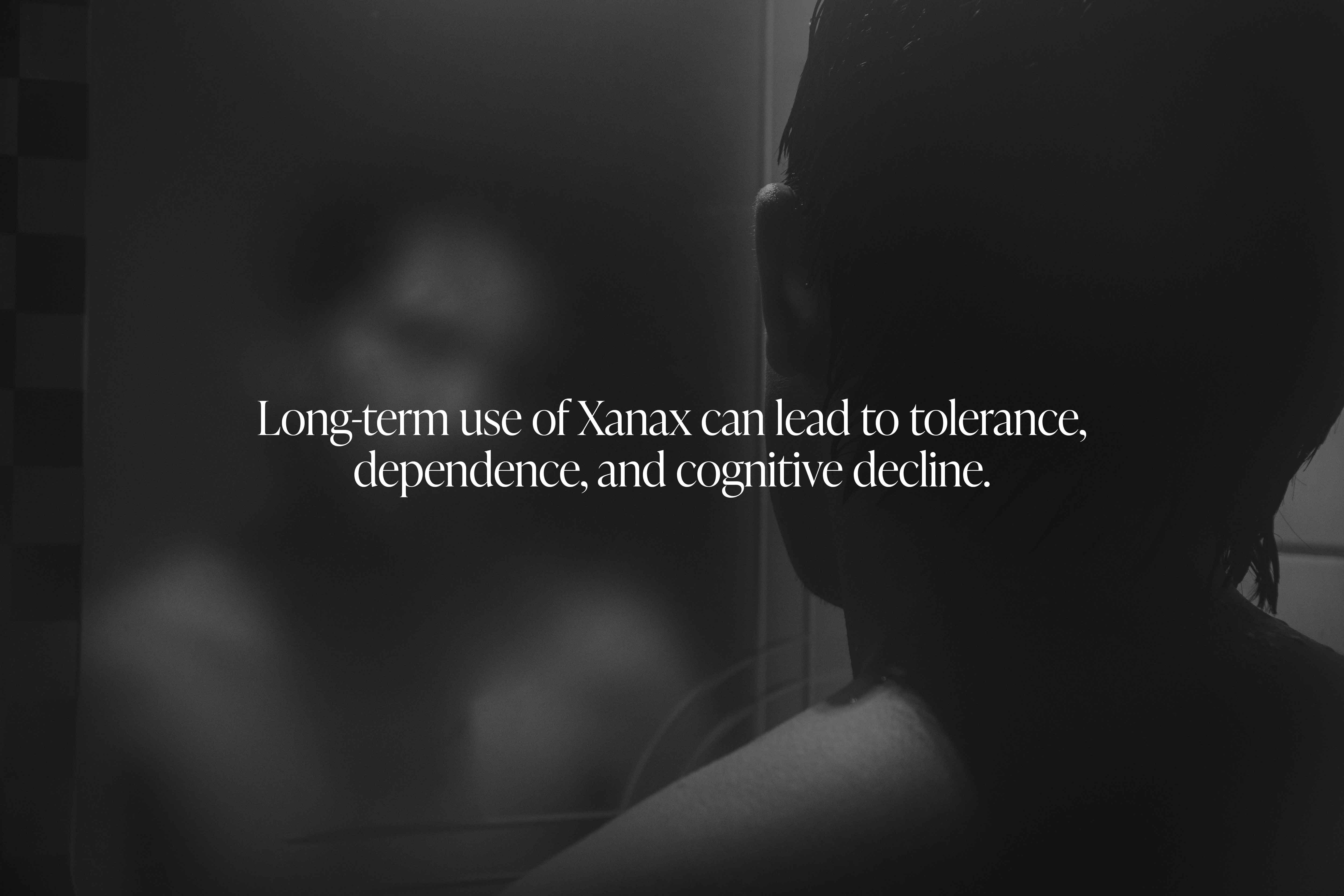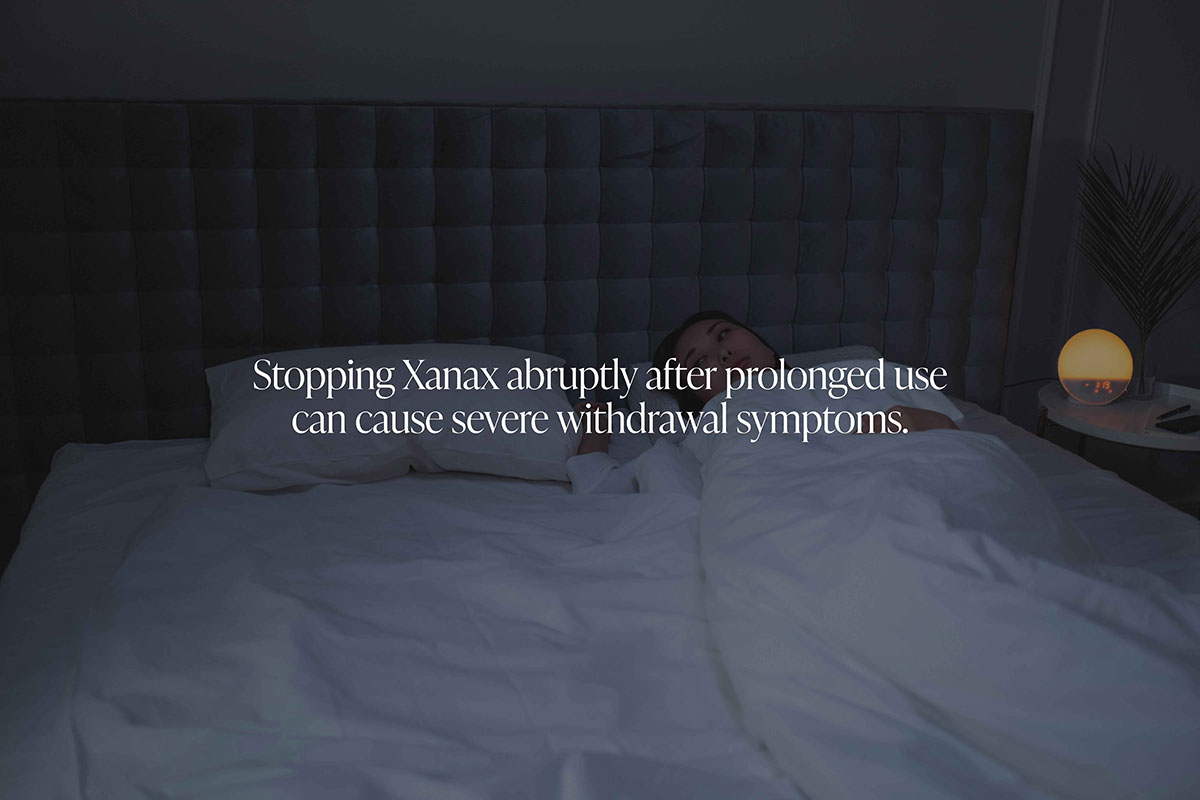Table of Contents
Xanax affects the brain and body by slowing down central nervous system activity. It produces calming effects by enhancing the action of gamma-aminobutyric acid (GABA), a neurotransmitter that reduces nerve activity in the brain. This action makes Xanax effective in treating anxiety and panic disorders but also introduces risks of sedation, dependence, and cognitive impairment when misused.

How Xanax Works in the Brain
Xanax, the brand name for alprazolam, is classified as a benzodiazepine. Once ingested, Xanax binds to GABA-A receptors in the brain. GABA is the brain’s primary inhibitory neurotransmitter, and its job is to reduce neural excitability.
By amplifying GABA’s effect, Xanax:
- Decreases activity in the amygdala (linked to fear and anxiety)
- Slows communication between neurons
- Induces a calming and sedative effect
This mechanism reduces anxiety almost immediately, typically within 30 minutes of oral administration.
Immediate Effects on the Body
Once Xanax enters the bloodstream, it spreads throughout the body and affects several systems:
- Nervous system: Reduces anxiety, induces drowsiness, and causes muscle relaxation
- Cardiovascular system: Slightly lowers blood pressure and heart rate
- Gastrointestinal system: May cause dry mouth, nausea, or constipation
- Motor coordination: Slows reflexes and impairs balance and coordination
These effects usually peak within 1–2 hours and can last up to 6 hours, depending on the dosage and a person’s metabolism.
Psychological Effects of Xanax Use
Xanax is effective for short-term anxiety relief, but it also produces psychological changes. Users often report:
- Euphoria or a “high” (especially at high doses or when misused)
- Emotional detachment or numbness
- Memory lapses (anterograde amnesia)
- Reduced ability to concentrate or think clearly
These effects become more pronounced with prolonged or high-dose use.
What Happens with Long-Term Xanax Use?

Long-term use of Xanax can lead to several physical and psychological consequences:
- Tolerance: The body becomes less responsive, requiring higher doses for the same effect
- Dependence: The brain adjusts to Xanax’s presence and requires it to function normally
- Withdrawal symptoms: When stopping suddenly, users may experience anxiety, insomnia, muscle cramps, or seizures
- Cognitive decline: Chronic use is linked to memory loss and difficulty concentrating
These risks increase when Xanax is taken without a prescription or used in combination with other substances like alcohol or opioids.
To learn more about the dangers of misuse and dependency, visit our benzodiazepine addiction treatment page.
Xanax and the Risk of Overdose
Xanax becomes extremely dangerous when mixed with depressants like alcohol or opioids. These combinations can lead to respiratory depression, a condition where breathing slows or stops altogether.
Signs of Xanax overdose include:
- Slurred speech
- Severe drowsiness
- Confusion or hallucinations
- Unresponsiveness
- Slow or shallow breathing
In cases of suspected overdose, immediate medical attention is critical. The use of flumazenil, a benzodiazepine antidote, may be required to reverse the drug’s effects.
What Happens When You Stop Taking Xanax?

Stopping Xanax abruptly after prolonged use can cause severe withdrawal symptoms. Because the brain has adapted to its presence, a sudden absence can trigger:
- Rebound anxiety or panic attacks
- Insomnia
- Tremors or muscle pain
- Seizures (in extreme cases)
Tapering off under medical supervision is the safest method. Treatment programs often provide detox support, therapy, and long-term strategies for anxiety management.
Why Some People Mix Xanax with Other Substances
In club and party settings, people sometimes mix Xanax with stimulants like MDMA or depressants like alcohol to balance the highs and lows. These combinations are dangerous because they mask symptoms, increase overdose risk, and complicate treatment if an emergency arises.
This type of behavior often overlaps with other synthetic substances. For example, what is pink cocaine and why is it so dangerous explores the growing use of unpredictable drug cocktails that include benzodiazepines.
How Long Does Xanax Stay in Your System?
Xanax has a relatively short half-life of 11 hours, but its effects wear off after 4 to 6 hours. However, it can remain detectable in the body for days depending on the type of test:
- Urine: Up to 4 days
- Blood: Up to 1 day
- Saliva: 2.5 days
- Hair: Up to 90 days
For more information, read how long does Xanax stay in your system.
Understanding the Link Between Xanax and Relapse
Xanax is sometimes used during early recovery as a way to self-medicate stress or anxiety, especially after withdrawal from opioids or stimulants. Unfortunately, this increases the risk of relapse. If you or someone you know is misusing Xanax during or after recovery, read what does it mean to relapse and how can you prevent it to better understand the warning signs and coping strategies.
Other Prescription Drugs That Work Like Xanax
Other benzodiazepines like Ativan, Klonopin, and Valium work similarly by acting on GABA receptors. While each has different onset times and durations, they carry the same risk profile. Visit our prescription drug addiction page to learn how to recognize patterns of misuse and seek help.












